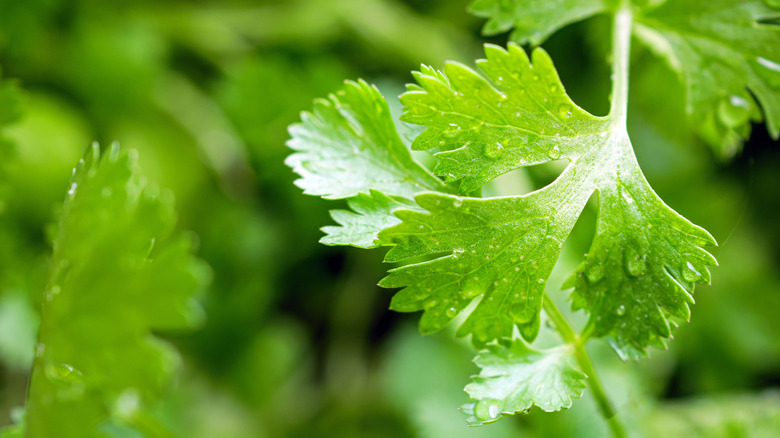Why Cilantro Should Be The Next Addition To Your Garden
You've done the basics: basil, rosemary, maybe even thyme are thriving in your DIY indoor herb garden. What should you tackle next? Cilantro. A bright, peppery herb common in Mexican, Indian and Southeast Asian dishes, cilantro has gained a bad rep for tasting like soap to certain people with a olfactory-receptor gene mutation — but so long as you don't fall in that camp, it's one of the best versatile additions to your herb repertoire.
It also has the benefit of being useful to chefs throughout multiple stages of growth. You might not know this, but coriander (a small, green, round seed often used in soups and meat rubs) — and cilantro (a leafy herb) actually come from the same plant. Cilantro's stalks and flowers are also edible. This means that it's useful in your cooking through several stages of its life cycle, making it a satisfying and useful plant easy to incorporate in all number of versatile, creative ways. Oh — and did we mention that cilantro makes your homemade salsa a whole lot more delicious?
This herb has a delicious growth journey. After planting cilantro seeds, you'll start to see small shoots within a couple of weeks. However, it may not be able to collect your first harvest until about 45 days into the process. Still, during this time, the plant might produce flowers, which you can pinch off and use as a garnish or blend into sauces as a flavor enhancer.
Factors to consider when growing cilantro
Continuously harvesting your cilantro can slow down the process of it moving into the flowering phase, which can affect the taste. That said, some people actually prefer the sharper flavor and stronger scent of the flowering plant, which also comes with thinner, frillier leaves you can use for all the same things you'd regularly use cilantro for (as a garnish, in a sauce, in a soup, and so on).
Coriander comes into the equation when the plant produces seeds. They will first grow as unripe and green. If you harvest them at this point, you can crush them and use their hulls, or skins, to add flavor to a corn salsa or fragrant sauce. Later, they'll dry out and turn a beige color (and become easier to use). These are the coriander seeds you likely already know and love, and they're typically ground up and added to spice mixes like Indian garam masala and Jamaican jerk seasoning. Their flavor can be described as sweet and fresh. You could also use the seeds whole as part of a meat rub, add them to a pickle brine, or even infuse whisky or gin with their flavor.
Consider planting a few separate rounds of cilantro in either the spring or the fall several weeks apart, so that you can have the herb available in multiple stages of growth. And if it's still too cold where you live to start the seeds outdoors, try this hack to turn a plastic takeout container into a greenhouse that will help your seedlings stay warm.

